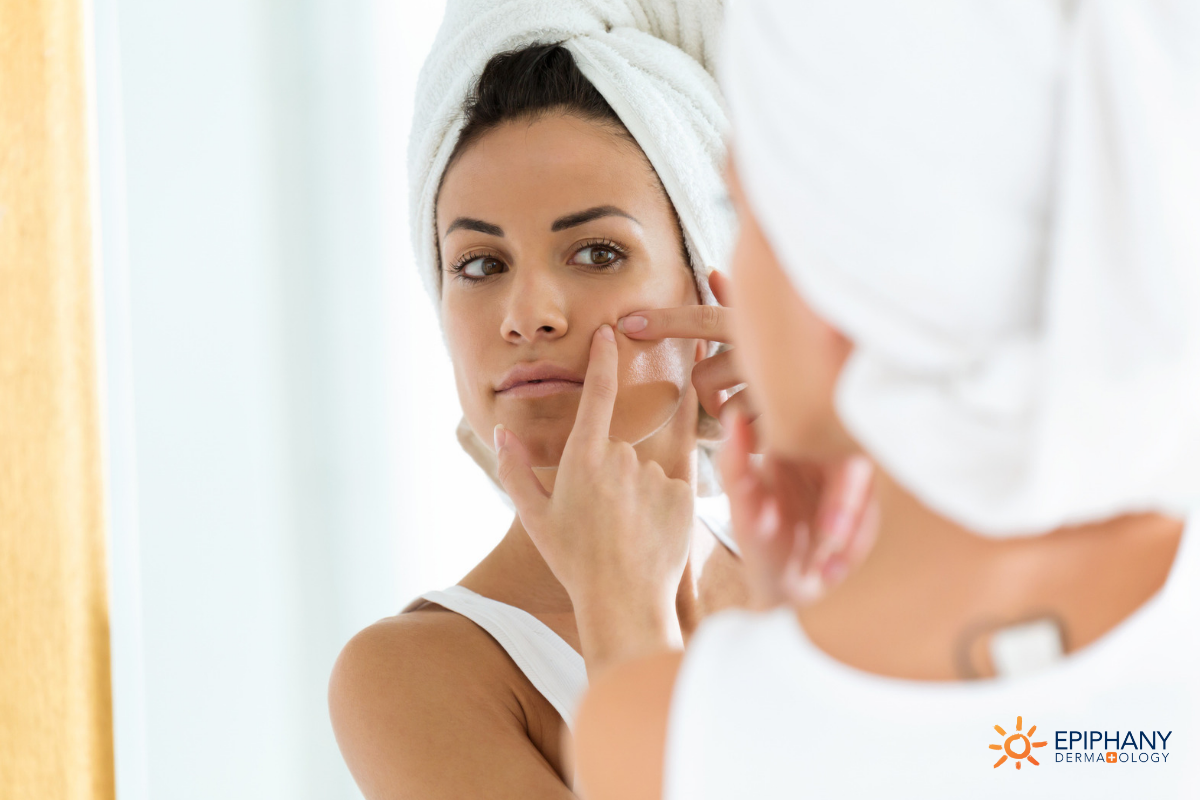We’ve all had our share of whiteheads and blackheads.
They seem to pop up out of nowhere, leaving us struggling to make them disappear as quickly as they arrived – but it’s usually not quite that easy. No one wants them, but until you understand what causes whiteheads and blackheads, it’s hard to know how to treat them.
What are whiteheads and what makes them different than blackheads or other types of acne?
More importantly, how do we get rid of these pesky pimples and get the clear skin we’ve been wishing for?
It’s not impossible.
Once you know what you’re dealing with, you can start the best blackhead and whitehead treatment for you. Here’s what you need to know about whiteheads vs. blackheads… and what you can do to treat them.
Whiteheads vs. Blackheads — The Basics
Blackheads and whiteheads are basically the same thing. They’re both classified as “non-inflammatory” acne — which means they aren’t infected. They’re just clogged pores containing dead skin cells and natural oils called sebum that need to come out of the skin. The difference is that the blackhead is in an open pore and the whitehead is in a closed pore.
Because the blackhead is in an open pore, it’s been exposed to the air. The chemical inside, melanin, has been oxidized by the air and turned the dead skin and natural oil inside black. The whitehead contains the same dead skin and natural oil, but because it’s been inside the closed pore and hasn’t been exposed to air, it stays a white color.
So, what causes whiteheads to stay closed and blackheads to open?
With whiteheads, the skin hasn’t ruptured yet. However, the pore only has so much space. As your body continues to produce oil and dead skin, the pore opens. If the pore remains clogged once it opens, the blemish turns to a blackhead as it oxidizes.
Face exfoliation can speed up the process of opening and unclogging the pores. With intense scrubbing, the pores open up and the whiteheads may change. Sometimes they rupture and the dead skin cells escape and begin to heal. Other times, the pore remains clogged and the substance inside changes to a black color, resulting in a blackhead.
What Causes Whiteheads vs. Blackheads?
Just as whiteheads and blackheads contain the same substance (it’s just a different color because of the air), they’re also caused by the same conditions.
When hormones produce more oils and dead skin than pores can handle, people get whiteheads and blackheads. For most, this increased hormone production is isolated to their teenagers and young adult years. As their hormones regulate, their oil production regulates too and pores stay clear.
Some adults aren’t as fortunate. Some people overproduce oil and dead skin well into adulthood. If they produce more oil than the pores can release, the pores clog and they’ll notice whiteheads and blackheads.
No matter the age, when bacteria finds clogged pores and begin to feed on it, that’s when whiteheads and blackheads turn into red, inflammatory acne.
How To Get Rid of Whiteheads and Blackheads
Blackhead and whiteheads treatments are very similar. We usually recommend patients start treating blackheads and whiteheads with over-the-counter products such as low-percentage retinol, salicylic acid, benzoyl peroxide wash, and/or exfoliant washes. St. Ives makes a great exfoliation wash that helps scrub off the tops of whiteheads, so the pores excrete the oil before it gets infected.
If you need a more aggressive treatment, prescription retinol gel works well against whiteheads and blackheads alike.
The main difference in whitehead treatment and blackhead treatment is the option to peel off blackheads with a pore strip. Neutrogena, Biore, and several other cosmetic brands offer pore strips that pull the blackheads out of the skin immediately. When using pore strips, apply it lightly to the area and be careful not to press down in such a way that forces the blackheads inward. As you remove the strip, the blackhead will stick to the paper and come out of your skin. Pore strips are a great way to treat areas like the nose where the skin is tight and blackheads easily peel off.
If you can’t get your blackheads and whiteheads under control with these treatments, we have additional prescriptions we can use to eliminate infection and inflammation.
Daily Care for Blackheads and Whiteheads
There’s no way to completely avoid blackheads and whiteheads… because there’s no way to completely avoid producing oil and dead skin. However, regular cleansing is very helpful in preventing breakouts.
Keep your skin clean. Wash your face with lukewarm (not hot!) water both morning and night. Use an exfoliating wash or gloves a few times a week. The goal is to unclog the pores.
Do not pop your blackheads or whiteheads. Squeezing them allows bacteria to enter the pore and causes them to become inflamed. It will only make the blemish worse.
No time to use water and cleanser? Consider using facial wipes for easy cleaning after a workout or while you’re on the go.
Also, remember the value of moderation. Don’t overdo the washing (you’ll produce more oil) and don’t indulge in too many fast food meals and soft drinks. Grease and sugar aren’t the cause of acne, but they don’t make it any better.
Blackheads and whiteheads are common — but that doesn’t mean you have to live with constant breakouts. Keep your pores clean and talk to your dermatologist about the best blackhead and whitehead treatment option for you.

Wesley Bull is a nationally certified physician assistant in Stephenville and Brownwood, TX with over 3 years of experience in family practice and a passion for medical dermatology. Wesley is devoted to providing comprehensive skincare to his patients, including general and surgical dermatology. A native Texan, he enjoys the outdoors and spending time with his wife Lesslie and their two children.

